TIAGRA
THE JEWEL IN SHIMANO’S CROWN
Shane Mensforth explains his love affair with one of blue water fishing’s true icons.
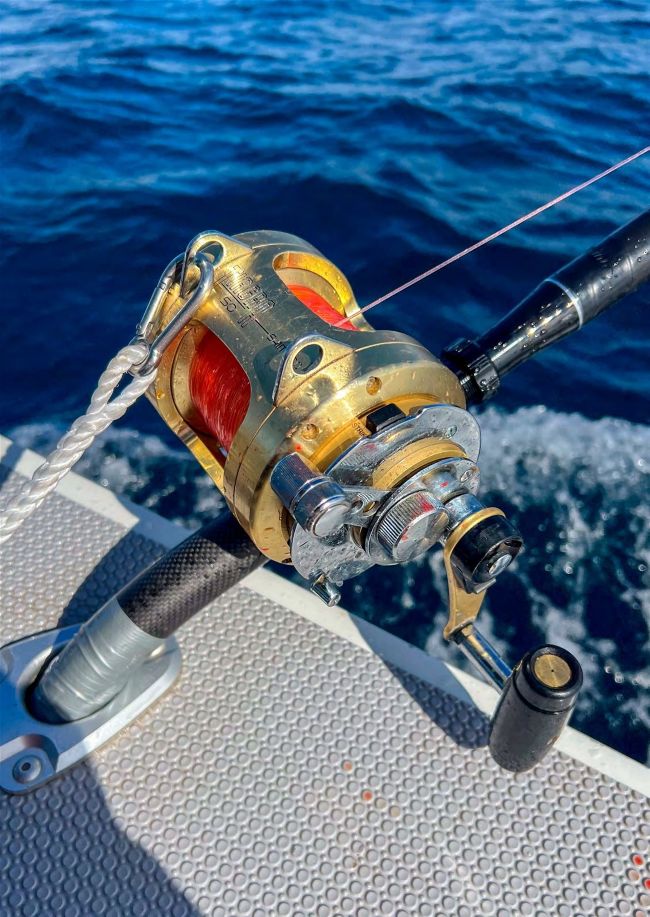
The author’s original 50 Tiagra, still going strong 30 years on
Back in another life I was briefly the SA sales rep’ for Dunphy Sports – the Sydney-based company that imported Shimano tackle into Australia. I had recently abandoned teaching and was looking for some ‘top up’ income to supplement my meagre earnings as an outdoor journalist, and when the offer came to join the Shimano team, I grabbed it with both hands. This was during the period when Shimano was just starting to shake off the tag as merely another dubious Asian brand and was establishing itself as a definite force in the Aussie tackle industry.
History will show that as a tackle rep’, I made a pretty good writer. The most significant criteria needed for a successful career in wholesale tackle at that time were (a) an intimate knowledge of the product range, (b) a strong drive to sell, regardless of what you were trying to sell, and (c) the ability to develop and maintain relationships with the retailers you were calling on. In just over two years I’d displayed none of those criteria, nor was I ever likely to, and my stint as Shimano’s South Australian agent wound down to its inevitable conclusion.
From all this carnage, however, emerged one shining light; Shimano boss and company owner, John Dunphy, and I became close mates. We had known each other from a distance for quite a while, mainly through Shimano’s involvement as an advertiser in SA Angler, and we had always hit it off. I think Dunph’ was impressed with what I was writing in both our magazine and the national publications at the time, and I admired his determination, skill and passion to make Shimano the country’s leader in fishing tackle. No doubt we shared plenty of common ground; he was always interested in my general input and, on occasions, my advice on tackle development.
There weren’t too many highlights during my time in wholesale tackle, but once a year all the state sales rep’s would get together to attend the AFTA (Australian Fishing Tackle Association) trade show, held in Sydney during that period. This was an exhibition of the major players’ new products, providing retailers with the opportunity to check out what was coming for the season ahead, and to place forward orders if they so desired. The AFTA show was also an enjoyable social gathering for all members of the tackle trade, as well as the fishing media, advertising companies and a host of national fishing celebrities. I loved being part of all this, and it was essentially the only thing I missed when my tackle sales career ultimately crashed and burned.
It was at the 1994 AFTA show that Shimano first introduced the Tiagra. For some time the company had been working on a replacement for its moderately successful Beastmaster series of blue water reels, and when the first Tiagras were rolled out at the tackle show, there was plenty of excitement in the Dunphy Sports camp. Penn had owned the premium lever drag game reel market for decades with its International series, and even though the brand new Tiagra looked and felt great, only a handful of serious anglers seemed to give it a second glance.
From memory, I think there were three Tiagra models on display at the AFTA show – a 20, a 30 and a 50. I know I was super impressed with their smoothness, for which the Shimano brand had already developed a reputation. These reels were an obvious step up from the old Beastmasters and, with the promise of future models to cover all line classes, I knew Shimano was onto a winner.
As the team was pulling down the stand at the conclusion of a highly successful tackle show, John Dunphy put his arm around my shoulder and handed me the Tiagra 50 from the display cabinet. He knew I was one of just a handful of his staff who actually fished seriously, and his instructions were for me to take the reel and catch something decent with it. I was quite blown away by this, and eagerly accepted the shiny new gem, along with one of Shimano’s brilliant Beastmaster BR1529RF short stroker rods. At that point I wasn’t sure whether or not Dunph’ intended for that combo’ to be returned at some stage in the future, but suffice it to stay I still have it – some 30 years down the track!
As things turned out, I didn’t get a chance to take the Tiagra on a serious fishing trip until the following January. I’d been invited to accompany George Flourentzou, George Mitris and skipper David Young to chase tuna and sharks out of Streaky Bay for a few days, so I loaded the reel with new 50 pound mono and packed a heap of lures and terminal tackle. We would stay aboard Flourentzou’s 45 Bertram, ‘Thresher II’, and fish the waters between Streaky and St Francis Island, trolling for bluefin by day and ballooning for sharks on anchor after dark.
As we’d hoped, the tuna action was about as hectic as you could get, enabling us to catch, tag and release dozens of 15-25kg fish during the first afternoon session. We kept a few to eat as well, enjoying fresh sashimi and barbecued tuna steaks for dinner that evening. Our first big baits, ballooned out amidst a berley trail of tuna guts and oil, brought almost instant hook-ups on hefty whaler sharks, a couple of which would have pushed 200 kilos. As it had been for much of the day, the action was non-stop, and we were forced to cease fishing before midnight to grab some sleep for our second assault on the tuna. To say we were all pretty knackered would definitely have been an understatement!
I woke up at around 4am and, as my Tiagra outfit was about the only one on board not to have caught a decent bronzie, I decided to send out a 30cm slab of tuna belly on a 12/0 hook and some 400lb nylon-coated wire – the standard whaler shark set-up back in those days. With the balloons bobbing away in the light offshore breeze some 50m astern, I settled back into the sleeping bag and must have nodded off quickly.
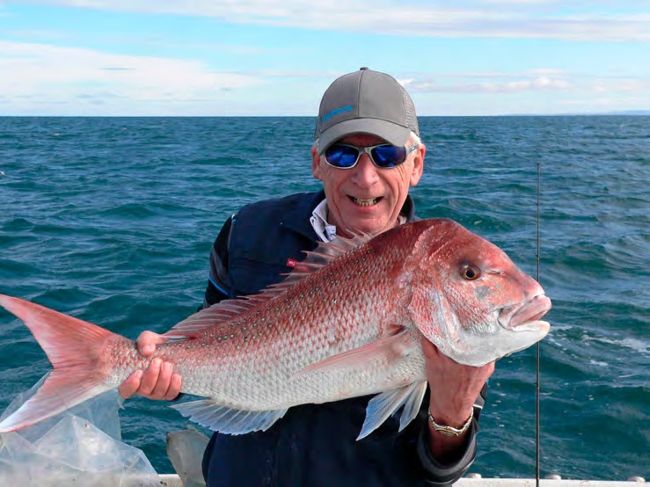
John Dunphy, Shimano Australia boss, left us too soon back in 2015
I awoke again just before seven o’clock, this time to the call of nature, and was just in the process of zipping up when the Tiagra began growling in the rod holder a couple of metres away. This wasn’t a screaming run, as had been the norm when one of the big bronzies had grabbed the bait earlier, but instead a steady unloading of line that had me scratching my head. By the time I’d managed to stir any of the crew into action to assist, more than half of the Tiagra’s line load had disappeared, and whatever was on the business end show no signs of slowing down.
I was getting dangerously low on line by the time David eventually managed to fire up the engines and retrieve the pick to give chase, and I can recall thinking that I must have hooked the biggest bronze whaler shark of all time. I’m guessing I was down to the last 50m of mono, as at one stage I could see the anodised gold spool beneath the final few strands of line. Thankfully, Youngie sensed what was going on down in the cockpit and gunned the big boat backwards at full noise to help me out.
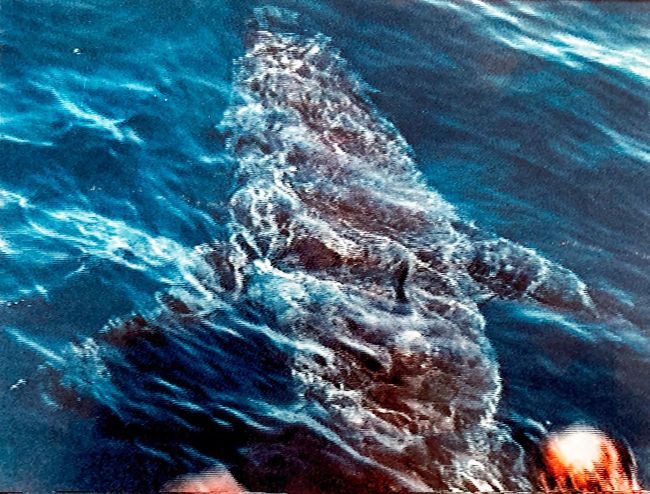
A still frame from VHS video is all that remains to bring back memories of the monster white shark from Streaky Bay in 1995
By this stage the two Georges were out with me, attaching a shoulder harness and rod bucket to relieve the pressure on my groin and forearms. Still the shark tracked to the north, maintaining a steady pace and still slipping line off from time to time, and it must have been at least half an hour before I managed to crank back the first few metres. Dropping the Tiagra down into low gear provided that small amount of mechanical advantage required to actually win back valuable monofilament, inch by inch. By this stage we were all pretty sure this was no whaler shark, and when an imposing triangular dorsal fin broke the surface a couple of hundred metres astern, our predictions were confirmed – this was a great white, and a bloody big one to boot!
To cut a long story short (a six-hour long story, in fact), we chased the shark northward for 16km (tracked by the GPS) before George Mitris eventually grabbed the top of the wire and managed to hold its head at the marlin board. George Flourentzou was super keen to gaff the monster and tow it back to Streaky for weighing, as it would easily have eclipsed Bob Dyer’s World Record for the 24kg line class, which had stood for decades at 850kg. However, just a couple of weeks before this trip I’d promised my father that I would never kill another great white. He had long been an advocate of protecting big sharks and, in line with his wishes, I had made the decision when I first discovered what I’d looked that it would be tagged and released.
We managed to get a pretty accurate estimate of the shark’s length, as Thresher II’s beam was exactly 16 feet, and when pulled in along the marlin board for tagging, it was precisely as long as the boat was wide. Unfortunately, there were no still photos of the shark taken at the time, but I did manage to grab a frame from the video footage shot by David Young, which provides at least some idea of its size.
I was totally spent by the time the shark had been tagged and released, and can recall throwing up everything I’d eaten for the past 48 hours on the cockpit floor. My right palm was severely blistered, my face was glowing from sunburn, and I was seriously dehydrated, as the marathon tussle had taken place in 36 degrees. In short, I was close to exhaustion and what I’d just achieved hadn’t begun to sink in at all.
After returning from Streaky Bay, I showed the video tape to several highly experienced shark fishing friends, including the legendary Rolf Czabayski, all of whom agreed that 1000 kilograms would have been a reasonable estimate of the shark’s weight. Not only would it have beaten Bob Dyer’s 24kg World Record, it was (and still is) most likely the biggest gamefish ever caught on stand-up tackle – and all on the first Shimano Tiagra 50 to lob in Australia. Naturally, John Dunphy and the Shimano team in Japan were pretty happy with all of this, and it was at that point I was confident that Dunph’ would allow me to keep his ‘test’ reel after all!
Tiagra has now been around in Australia for 30-odd years and, apart from a few minor cosmetic improvements and a little tinkering with sizes and models, very little has changed. The range now offers nine models to cater for lines from 8-60kg, but these line figures are quoted for monofilament and can be played with ad infinitum for braid. I own two Tiagras currently — a 30TWLRS (Tournament Wide Long Range Special) that’s probably 15 years old now, and that original 50 mentioned in the story above that has recently turned 30. I’ve had a couple of others along the way, including a 50TWLRS and a 16, which were moved on when they became superfluous to needs at the time.
That Tiagra 50 quickly became my go-to shark fishing reel, landing heaps of big bronzies from both boat and shore. It has also knocked over some decent kings in Australia and New Zealand, a nice blue marlin in Tonga, a monster wahoo in Fiji and several yellowfin tuna in Vanuatu to around 60 kilos. These days it’s quite battle scarred, but still works as well as it did straight out of the box. Those who know my tackle maintenance routine won’t be surprised to learn it has been serviced just twice in its working lifetime – on both occasions sent back to Shimano in Sydney for a quick pull-down, relube and inspection, and on both occasions it came back with a clean bill of health.
That reel has been matched to several rods over the journey, including the original Beastmaster short stroker, a Steve Morris-built Status 24kg custom job, a Tiagra T-Curve 24kg stand-up model and, most recently, a new Shimano 60-100 pound stand-up designed primarily for chasing swordfish and tuna in deep water.
The Tiagra 50 hasn’t done a lot of work in the past few years, but Brett and I decided to extract the digit when the ‘barrel’ bluefin turned up off southern Yorke Peninsula this winter. Brett bought himself a new Tiagra 30 wide and Shimano 60-100 pound stand-up rod, a new harness/bucket setup and some locally-made lures from Troll So Hard. We respooled all reels with 80 pound Power Pro braid and a 50m top-shot of 150 pound mono, sorted out gaffs and tail ropes, and generally assembled all the bits and pieces required for heavy tackle offshore tuna fishing. Neither of us had fished for barrels out of our own boat before, and there would be no falling back on a charter crew for assistance. We simply had to have the whole scenario sussed and sorted.
Interestingly, the Tiagra 50 and 30 wide hold about the same amount of line – 750m of braid plus the top-shot, which is what you need for tackling 100kg-plus bluefin. These fish can take an amazing amount of line on their initial run, so it pays to keep the reel full, even when fishing from a fast, manoeuvrable boat.
The big tuna had been lurking off Marion Bay for a few weeks before we could eventually get out to them. Two trips were aborted due to the weather, but eventually we jagged a day with low swell and light winds, and had the Bar Crusher in the water as the first hint of sunrise appeared in the east. The Marion Bay ramp was its usual disgraceful self, with half a metre of weed blanketing the concrete slab, and without the Easy Tow trailer’s extended drawbar I doubt we would have got the boat in at all. Thankfully, this is all about to change, as work is well underway for a new and long overdue launching facility.
Joining Brett and me on our maiden barrel mission was Ben Harris, from Stansbury. He, too, was in full big fish mode, with a newly acquired Tiagra outfit and all the paraphernalia to go with it. Ben had been on board a mate’s boat a fortnight earlier and had helped to land a bluefin estimated at 130kg. Like Brett and me, he was busting to catch one of his own.
We dropped four lures over the transom just as we passed Seal Island – three big TSH skirts behind spreader bars and a Nomad deep diver. There was plenty of activity all around us in the form of common dolphins, seals and seabirds, and the sounder screen indicated vast schools of baitfish throughout the general area – precisely the combination you are looking for when you’re hunting big tuna.
A couple of hours later, however, we hadn’t turned a reel and made the decision to head out wide of Althorpe Island. The birdlife had evaporated, and it was obvious we would now have to put in the trolling miles to give ourselves a chance of finding what we were after.
By lunchtime our collective spirits were beginning to wane. The ocean seemed devoid of life, and when we couldn’t even raise a nannygai from a couple of usually productive deep-water lumps, things were looking grim indeed. At around two o’clock we abandoned the bottom fishing and opted to resume trolling, with the rough plan of working our way back around Althorpe Island and trying for tuna until 4.30. With the Marion Bay ramp in such bad condition, there was no way any of us wanted to be trying to retrieve the Bar Crusher in darkness!
We had circumnavigated Althorpe twice and trolled our way along a depth contour that had produced tuna over the preceding fortnight, when just a handful of terns and a single gannet popped up in front of us. These were the first birds we had seen in six hours, and before we had even reached them, Ben’s reel went off in spectacular fashion. A few seconds later Brett’s Tiagra began to howl, too – double hook-up!
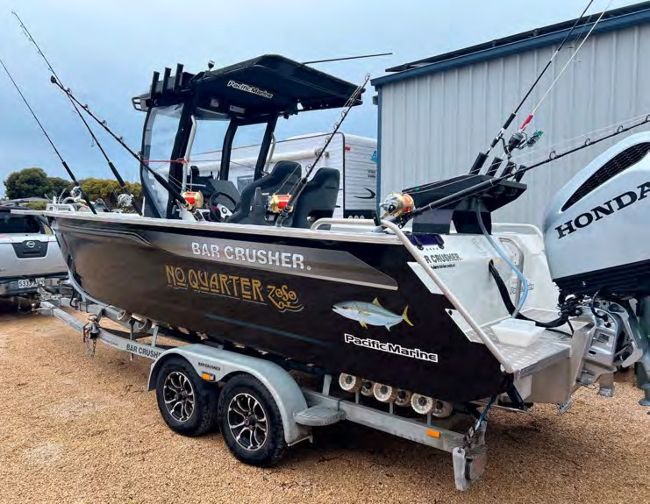
I was left to clear the other rods, grab harnesses for the boys and generally make space in the cockpit for them to do battle. Ben’s fish had half emptied the reel before I could get the boat turned and heading the right way, but Brett’s decided to stay closer and lug away down deep. Naturally, it’s only possible to chase one bolting tuna at a time if they are heading in different directions, and as Brett seemed to be in control quite quickly, we made the call to try to get his fish first. By switching the reel between high and low gear – a Godsend when trying to put the hurt on big, stubborn fish like barrels – Brett was able to inch back his line load. In just 20 minutes he had the top-shot back on the spool and seemed well in control.
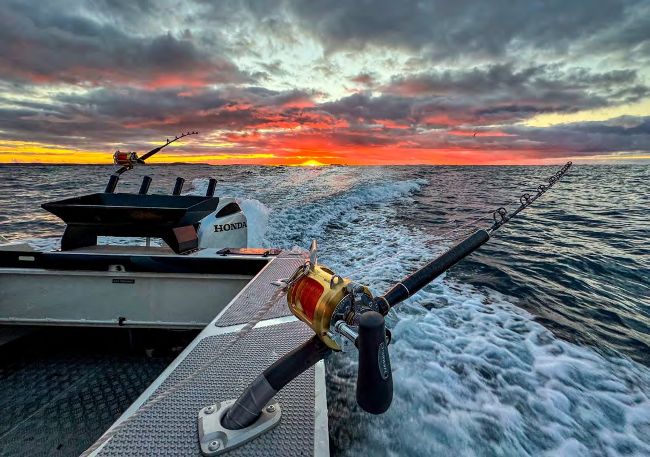
Locked and loaded for a dawn trolling session south of Marion Bay
Meanwhile, Ben’s Tiagra looked decidedly unhealthy, with at least 400m of braid stretching out toward the horizon. His tuna had settled somewhat by this stage, however, arcing across the top and obviously puffing as much as Ben was. I hit Brett’s fish with the gaff just 25 minutes after hook-up, and then the real fun began. There was no way Brett and I could heft the 100kg-plus bluefin over the Bar Crusher’s gunwale, so we opted to pull it down the starboard side and attempt to drag it through the transom gate. I’m not sure exactly how we managed this, but eventually we got the tuna’s head and shoulders through the gate and then, with one mighty heave, got it moving until momentum took over and it came aboard.
It took just a few minutes to run down Ben’s fish after all this, and when it eventually popped up near the boat, there was scarcely any sign of life. This tuna had literally burnt itself out, and it hardly even flinched as the gaffs went in and it hit the deck. Naturally, there were high fives all round, and although I had missed out, my spirits were as high as the boys’. These were not just the biggest tuna, but the biggest fish either Brett or Ben had ever caught. I was a proud dad indeed!
We ate bluefin in just about every conceivable way over the following week, as well as sharing it with friends and family. It really is a superb fish that lends itself so well to all manner of culinary alternatives. We ate bucket loads of sashimi, we had marinated steaks on the barbecue, we made Asian curries and stir fries, and I stacked away several packets in the freezer to be smoked at some stage down the track. Suffice it to say, not one mouthful of that fish went to waste.
So, both Ben’s and Brett’s new Tiagra outfits had been christened on magnificent fish. The reels had performed faultlessly and the new 60-100 pound stand-up rods from Shimano proved to be the potent weapons we hoped they would. They fished 80 braid to the max, enabling the boys to knock over their tuna in surprisingly short time. As Brett had a rostered day off a week or so later, he decided to make a quick trip across to my place on Yorke Peninsula for one more shot at the barrels. He knew I was busting to catch one from my own boat and, with a near flawless 24-hour weather window on offer, we hitched up and headed to Marion Bay once again. It would be just him and me on board this time, which was sure to make things more of a challenge if we were lucky enough to find the big tuna for a second time. As we all love a feed of nannygai, we also threw a couple of bottom fishing outfits on board, as well as a bag of squid heads for bait.
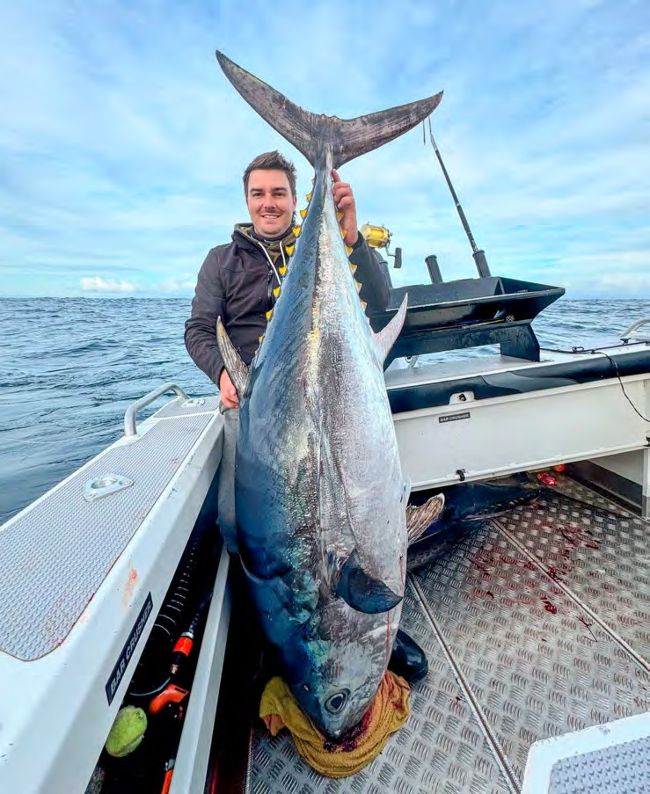
Ben Harris with his first big bluefin, hooked near Althorpe Island
Again the sea was calm as we rounded Penguin Point and headed southward towards Althorpe Island, with no swell and a beautiful sunrise to kick off the day. There was no obvious birdlife, however, nor were there any dolphins to greet and guide us, so we simply put three lures out and commenced a long, slow trolling run to the south-west.
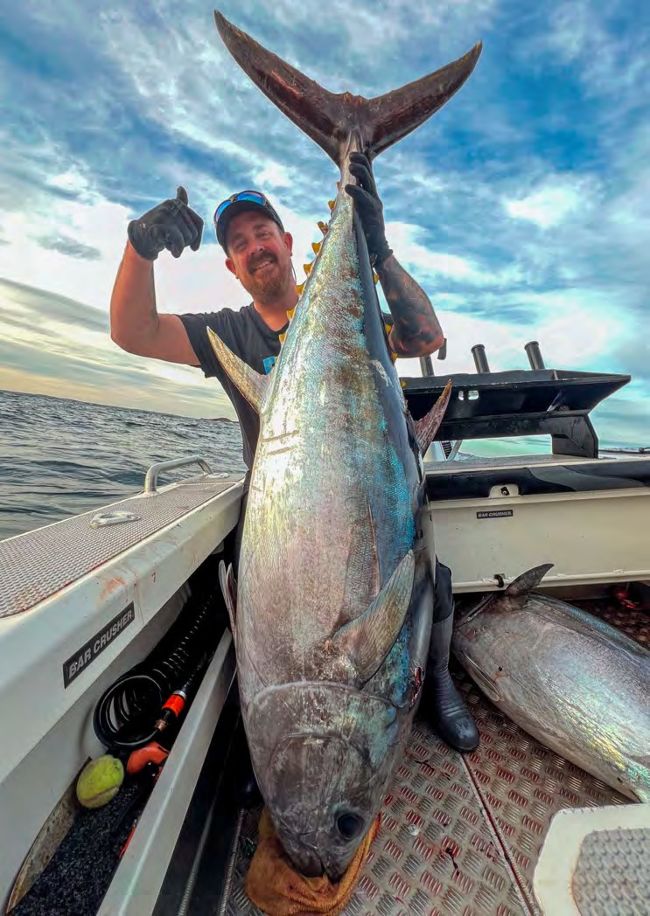
Brett’s PB bluefin, part of a double hook-up
We had passed the western end of Althorpe by a couple of miles when I spied a small flock of terns, probably 500m or so directly ahead. We had all but reached them when a giant of a tuna cleared the water completely, and immediately the excitement level on board reached new heights. The barrels were obviously still around! Despite trolling this area for at least another hour, however, all remained quiet out back. The trio of trolling lures skipped along seductively, but totally unmolested in our wake, and gradually those excitement levels began to subside once more.
Back near the tip of Althorpe Island Brett spied a plume of spray way off in the distance – quite obviously from a whale – and we decided to head in its general direction. Barrel bluefin are occasionally hooked near whales in locations like Portland and Port MacDonnell, so it made sense to at least give the big humpback some attention. I was keen to grab a bit of whale video, too, so we opted to make our way to where we’d seen it last, keeping the lure spread intact and maintaining the usual 8-9 knot troll speed.
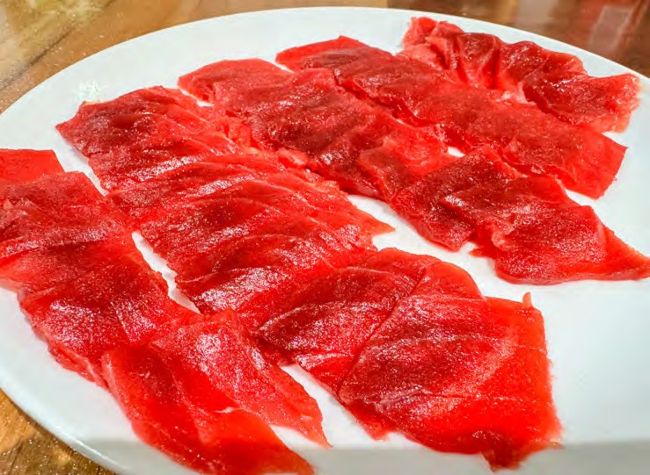
Barrels definitely make the best sashimi
It turned out to be a mother and calf, which were great to watch from a reasonable distance, and I managed to bang off a few nice stills and some IPhone video as they rolled, spouted and generally put on a show for us. Quite a few dolphins had joined the festivities by this stage, and mountains of baitfish began to show on the sounder screen, and when my Tiagra lit up in the portside holder, it was action stations on board the big Bar Crusher.
That first run against heavy drag was about as spectacular as it gets, and I could sense the adrenaline coursing through me as I wrestled the rod from the holder and clipped on the harness. Brett had the other two lines cleared in double quick time and we were off to give chase. We’d hooked up in just 21m of water and less than half a kilometre off the Althorpe Island jetty, so there was no going deep for this bolting barrel. The Tiagra drag hummed as line evaporated from the big golden spool.
Despite almost getting onto the plane at times, it was no easy feat to keep up with the tuna as it sprinted to the west. Eventually, however, it began to slow and settle into a steady pace at mid water, enabling me to finally crank some line back onto the spool. Once again, dropping down into low gear from time to time allowed me to regain some sort of control, and by changing the boat angle frequently I was able to begin planing the fish to the top, albeit still a couple of hundred metres away.
Just a few minutes later I had the 50m nylon top-shot back on the reel, which gave my confidence a definite lift and, before we were really ready for it, the big tuna popped up only 20m off the starboard side. Like Ben’s fish a week earlier, this one was almost completely spent, allowing Brett to grab the leader and drag it boatside with zero resistance. I hadn’t made the call during the fight to gaff or release, but when the tuna started spewing blood from its gills, I opted to take it. The lure was way down in the gill region and the magnificent creature showed little sign of life, so Brett sunk one gaff, I followed up with a second and the tussle was over.
This fish was noticeably bigger than either of the two we’d caught previously, and getting it into the boat was set to be a real issue with just Brett and me on board. I was close to stuffed after really putting it to the tuna from the outset, and knew I couldn’t offer that much during the landing process, but somehow we managed to wrestle/drag/haul its bulk through the transom door. I can tell you it was a pretty special moment in my lengthy lifetime of fishing; catching a bluefin of this size in my own boat and with my son at my side is something I won’t forget in a hurry!
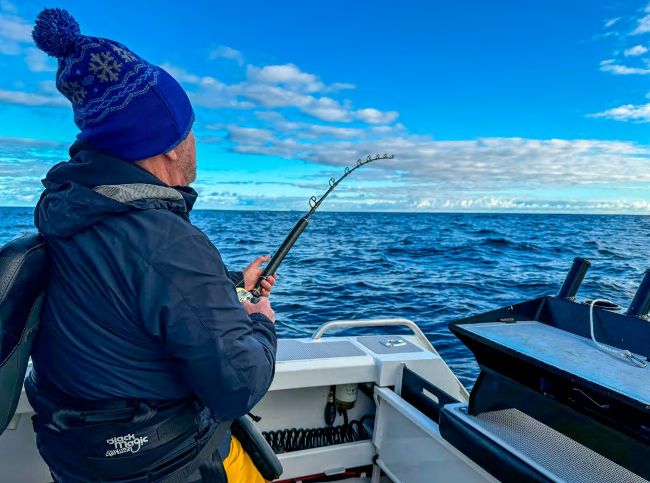
The author getting stretched on 80 braid

130 kilos of southern bluefin, hooked on an 8.5” Redbait TSH lure
I recall giving the Tiagra a rather ridiculous hug after all the mayhem had dissipated, and wondering what John Dunphy might be saying as he looked down from the great fishing grounds in the sky. John left us a few years back, much to the dismay of all who knew him, and I looked up and gave him a wink as I stashed the rod in the transom rack and settled back into the helm seat to regain composure.
That was it on the tuna front for the day. We trolled again for several hours before dropping the pick and knocking over a dozen big nannygai for the table, but the lures went un-noticed and we called it quits at around 4pm. As anticipated, retrieving the Bar Crusher back at Marion Bay proved yet another nightmare, but not even this horrid boat ramp could wipe the smile from my face. At 190cm to the tail fork and around 130kg, this was my biggest ever bluefin, and most likely the last I’ll ever kill.
There is no doubt Shimano’s time-proven blue water war horse, the Tiagra, will always be the jewel in the company’s crown – at least as far as I’m concerned. From giant sharks to giant tuna, it’s been a winner for me over three decades – and hopefully it’s not finished just yet!